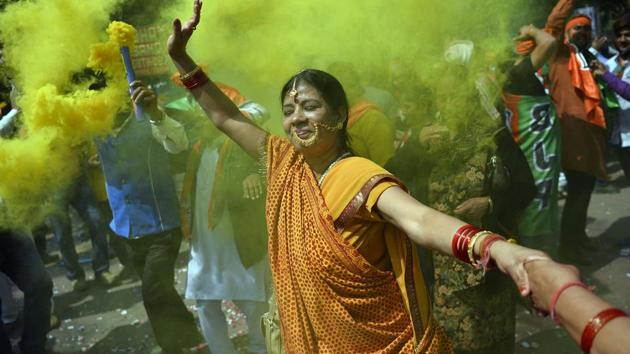Riding ‘Brand Modi’, BJP set to storm to power in Uttar Pradesh, Uttarakhand
Winning the politically crucial state, Uttar Pradesh, will boost Prime Minister Narendra Modi’s chances of getting a second term in the national elections in 2019. .
The Bharatiya Janata Party was on course for stunning election victories in Uttar Pradesh and Uttarakhand on Saturday, in a personal triumph of Prime Minister Narendra Modi that might ensure his party’s near-domination of politics in India.

Votes were also being counted to elect new assemblies in Punjab, Goa and Manipur.
But the biggest surprise was from the battleground state of Uttar Pradesh, where counting trends signalled ringing endorsement for Prime Minister Modi’s stewardship of the economy, especially the controversial decision to scrap 500-and 1000-rupee banknotes.
Trends showed the party leading in 303 of the state’s 403 seats, leaving the Samajwadi Party-Congress alliance way behind at 71 seats. The Bahujan Samaj Party, once a dominant power, faced decimation.
For Modi, who staked his personal reputation on a high-octane campaign in Uttar Pradesh, winning the politically crucial state will boost his chances for a second term in the national elections in 2019.
For live updates of Goa and Manipur results, click here
For our live coverage, click here
Early trends also suggested a clean sweep for the BJP in Uttarakhand, where the Congress is now in power. The party was leading in 58 of 70 seats for which trends were available. State chief minister Harish Rawat lost one seat (Haridwar) and was trailing in another he contested.
In Uttar Pradesh, the BJP campaigned on Modi’s pro-development credentials as well as its Hindutva agenda that appeared to have helped consolidate votes on religious lines.
In a state where people tend to vote along traditional caste and religious lines, and successive governments exploited communal divisions to fire up their base, Modi appears to have managed to expanded his appeal among a cross section of castes and sub-castes that traditionally voted for the Samajwadi Party and Bahujan Samaj Party.
“It is a Modi wave. The wave which started with 2014 Lok Sabha elections is continuing in 2017 and the momentum will go beyond the 2019 general elections,” said party state chief Keshav Prasad Maurya, a front-runner to be the next chief minister.
Early counting showed the BJP’s vote share in Uttar Pradesh to be more than 40% (the party got 42% votes in Lok Sabha elections in 2014), a stunning achievement likely to be credited to Amit Shah, the BJP president and Modi’s chief election strategist.
CONGRESS REGAINS PUNJAB, AAP FADES
Exit polls, which have a patchy record in India, had shown the BJP would storm to power in at least three states, including Uttar Pradesh where the party is trying to regain power after about 15 years.
At stake were also the survival of the Congress and relevance for a clutch of regional outfits, especially for Aam Aadmi Party chief Arvind Kejriwal’s ability to take his party beyond the national capital, where it won power in 2015.
Early trends did not bring happy news for Kejriwal. The party was trailing behind the Congress in Punjab which was leading 61 of 115 seats for which trends were available. State chief minister Parkash Singh Badal was ahead of Congress’s Captain Amarinder Singh in Lambi. Singh was, however, leading in his home seat Patiala.
The AAP might also fail to make any impression in Goa, with its chief minister candidate Elvis Gomes losing his pocket borough.
In Manipur, the BJP and Congress were seen neck-and-neck.
“People have fought the elections on our behalf in Uttar Pradesh and Uttarakhand and results have vindicated their faith in us,” BJP general secretary Kailash Vijayvargiya said.
For our complete coverage of assembly election results, click here





